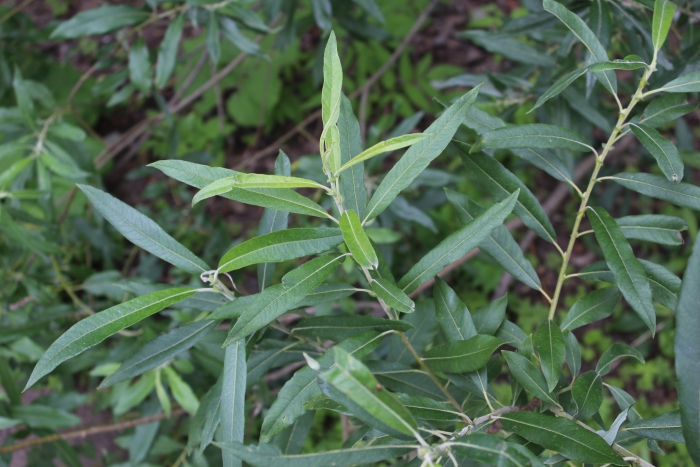Shining Willow
(Salix ×calodendron)
Shining Willow (Salix ×calodendron)
/
/

© Dmitriy Bochkov
CC BY 4.0
Image By:
© Dmitriy Bochkov
Recorded By:
Copyright:
CC BY 4.0
Copyright Notice:
Photo by: © Dmitriy Bochkov | License Type: CC BY 4.0 | License URL: http://creativecommons.org/licenses/by/4.0/ | Uploader: convallaria1128 | Publisher: iNaturalist |

























Estimated Native Range
Summary
Salix ×calodendron, commonly known as Shining Willow or Giant Willow, is a deciduous hybrid tree. It is native to wetlands, riparian zones, and other moist habitats in North America. This willow typically grows rapidly to a height of 20-80 feet (6-24 meters) and a width of 15-40 feet (4.6-12 meters), with a broad, open crown. The flowers are catkins, with the male catkins being yellow and showy, and the female catkins green and more inconspicuous, both blooming in early spring. The bark is smooth and gray when young, becoming furrowed with age.
Shining Willow is valued for its ability to thrive in wet conditions and is often used for erosion control along waterways. It is also planted for wildlife habitat enhancement, as it provides food and shelter for various species. In cultivation, it requires full sun to part shade and prefers medium to wet, medium to slow-draining clay or loam soils. It is relatively easy to maintain but can be susceptible to willow beetle and canker diseases. Due to its vigorous root system, it should not be planted near sewer lines or foundations. Salix ×calodendron can be potentially invasive outside its native range, so it is important to consult local guidelines before planting.CC BY-SA 4.0
Shining Willow is valued for its ability to thrive in wet conditions and is often used for erosion control along waterways. It is also planted for wildlife habitat enhancement, as it provides food and shelter for various species. In cultivation, it requires full sun to part shade and prefers medium to wet, medium to slow-draining clay or loam soils. It is relatively easy to maintain but can be susceptible to willow beetle and canker diseases. Due to its vigorous root system, it should not be planted near sewer lines or foundations. Salix ×calodendron can be potentially invasive outside its native range, so it is important to consult local guidelines before planting.CC BY-SA 4.0
Plant Description
- Plant Type: Tree
- Height: 20-80 feet
- Width: 15-40 feet
- Growth Rate: Rapid
- Flower Color: N/A
- Flowering Season: Spring
- Leaf Retention: Deciduous
Growth Requirements
- Sun: Full Sun, Part Shade
- Water: High
- Drainage: Medium, Slow, Standing
Common Uses
Bank Stabilization, Erosion Control, Water Garden
Natural Habitat
Native to wetlands, riparian zones, and other moist habitats in North America
Other Names
Common Names: Giant Willow
Scientific Names: , Salix ×calodendron, Salix xcalodendron, Salix ×acuminata,
GBIF Accepted Name: